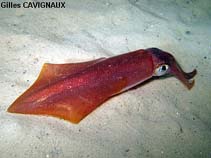Loligo vulgaris Lamarck, 1798
European squid| Native range | All suitable habitat | Point map | Year 2050 |

|
| This map was computer-generated and has not yet been reviewed. |
| Loligo vulgaris AquaMaps Data sources: GBIF OBIS |
Classification / Names Common names | Synonyms | CoL | ITIS | WoRMS
Cephalopoda | Myopsida | Loliginidae
Environment: milieu / climate zone / depth range / distribution range Ecology
Benthopelagic; depth range 0 - 500 m (Ref. 275), usually 20 - 250 m (Ref. 275). Temperate; 13°C - 20°C (Ref. 2453), preferred 18°C (Ref. 107945); 60°N - 36°S, 19°W - 37°E
Distribution Countries | FAO areas | Ecosystems | Occurrences | Introductions
Eastern Atlantic and the Mediterranean: from North Sea and British Isles to southwest Africa and the Mediterranean.
Length at first maturity / Size / Weight / Age
Maturity: Lm 16.9, range 16 - 23 cm Max length : 64.0 cm ML male/unsexed; (Ref. 417); 32 cm ML (female); max. published weight: 1.5 kg (Ref. 275)
Short description Morphology
Life cycle and mating behavior Maturity | Reproduction | Spawning | Eggs | Fecundity | Larvae
Main reference
References | Coordinator | Collaborators
Piatkowski, U. 2006 Loligo vulgaris. European squid. Life history species review. CEPHSTOCK: Cephalopod Stocks in European Waters. Review, Analysis, Assessment and Sustainable Management. 25 p. (Ref. 2488)
IUCN Red List Status
(Ref. 130435: Version 2025-1)
CITES status (Ref. 108899)
CMS (Ref. 116361)
Threat to humans
Human uses
Fisheries: commercial
FAO - Fisheries: landings | FishSource | Sea Around Us
Tools
More information
Max. ages / sizes
Length-weight rel.
Length-length rel.
Length-frequencies
Mass conversion
Abundance
Internet sources
BHL | BOLD Systems | CISTI | DiscoverLife | FAO(Fisheries: ; publication : search) | Fishipedia | GenBank (genome, nucleotide) | GloBI | Gomexsi | Google Books | Google Scholar | Google | PubMed | Tree of Life | Wikipedia (Go, Search) | Zoological Record



